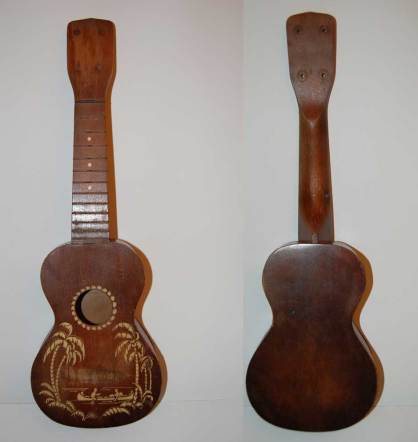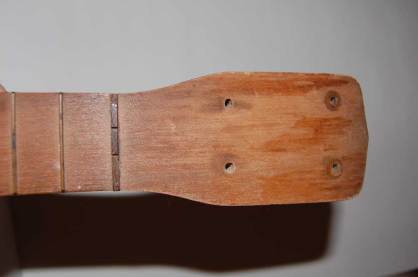Harmony Uke Project
March 5, 2009

harmony soprano
I started this post a while ago – it has been lounging in the draft pile.
A coworker, Kathy, found her family ukulele during her most recent summer visit. It’s an instrument that she remembered playing with as a small child. The uke recently turned up in the attic of her parents house after a 30 year or so hiatus — living with the unmatched socks or wherever family heirlooms hide undetected for 30 years.
Anyhow the uke is back.
There is a bit of a story here. The uke as found was in pieces. Dry as a bone. The top and back had the graceful modern curves of a Pringle. The sides were still connected but the shape had bowed out to half way between a pineapple uke and a standard uke silhouette.
Kathy brought the parts in to show me. She asked casually how one would go about re-gluing the uke. I gave her the 2 minute explanation of how I would attempt it. Flatten the top, draw the outline of the flat top on a piece of 3/4″ plywood. Add a zillion brads around the outline. Soak the body and stuff it behind the brad fence. Let it dry for a while then glue/clamp the top to the sides as best as possible, then repeat with the back. I offered her clamps and glue.
Little did I know…she was actually going to re-glue the uke (!!)

not too bad
It’s not perfect, but it’s a pretty damn respectable job considering that she didn’t have any clamps.
So here it is. My task is to get a bridge and some tuners on the uke and make a new nut – At the least make it into a decent wall-hanger.
Yeargh!…The dilemma. What now?
Please don’t tell Kathy, but I may take the top off again. I went ahead and made some one-off bridge clamps, but a closer look reveals what appears to be a healthy crack in the top. I originally thought I wouldn’t have to take the uke back apart.
Closer look #2: It seems that the strings won’t clear the top where the neck joins the body. That with the fact that there is no bracing gives me visions of loud pops followed by hail of splinter shrapnel if I tried to string the uke in this condition. I can’t imagine that the book-clamped glue on the top taking take the strain even if the crack didn’t fly open.
I have never seen a Harmony uke up close. They are surprisingly rough – especially considering that they command decent prices when they are found in good condition. The wood seems to be dyed birch. The top and back are solid wood, but a fairly clunky 1/8″ thick. The sides are the same thickness. The teeny holes on the pegboard make me think that it originally was outfitted with scrawny ancient tuners on it at one point. Not sure what age range this puts the uke, later than the violin-peg tuners, but still with a wood fretboard.

so where did the pegs go?
The frets are that old thin gauge brass – pure unobtanium, so I can’t replace the 13th fret (there were 13 frets?!?!?) The 12th fret is present and accounted for – so close enough. The fret markers are paint dots. The neck is pegged into the body with a single dowel. The nut looks like it was made of rosewood.
August 18, 2009 at 7:37 am
I have an old Harmony with the brass frets set into the neck, no fingerboard, supposedly around later 1920s, early 30s.
I also just got a Louis Gaspar pineapple off eBay, everyone else shied away, I saw a beater I could glue up and if the neck was straight there would be my pineapple. Yours was the most info I could find other than he was taught by Sam Kamaka Sr.. It looks like the neck and headstock is all monkey pod, the rest is koa. It is a funky little thing, wonky is the right word, but I said a little prayer and tuned her up, the strings looked new, and she’s sweet! Worth having a luthier take the back off instead of me, look inside, make sure the two front cracks are stable (seem to be solidly if not neatly glued) and put it back on cleanly. Can you please tell me what you think about it? If not, at least know somemone else out there found one to love. 😉 BTW, Nice copy!

August 18, 2009 at 7:40 am
Oh, and those original tuners were old black standard pegs but the shaft is a very fine thin square, never seen another quite like it. If it’s just a player (and should be), drill them out to fit some current cheap standard Gotohs.